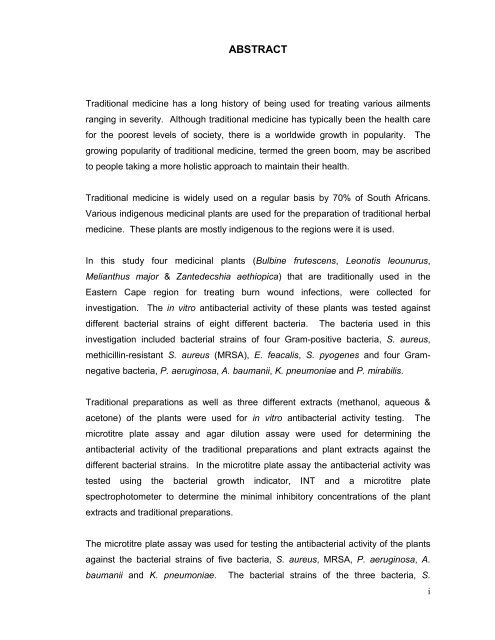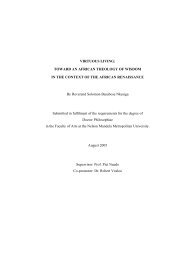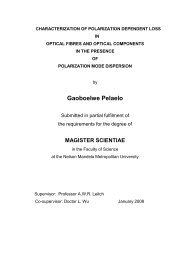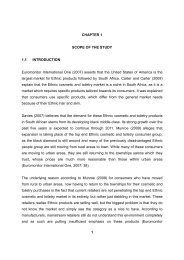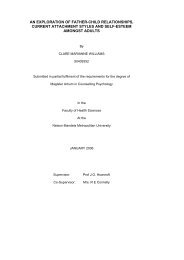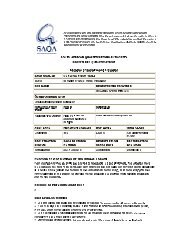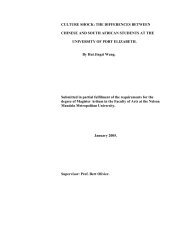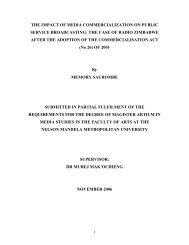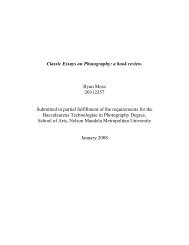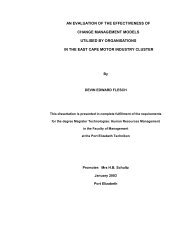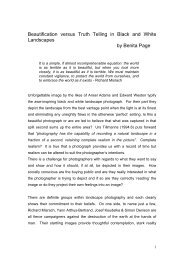an investigation into the antibacterial activities of medicinal plants ...
an investigation into the antibacterial activities of medicinal plants ...
an investigation into the antibacterial activities of medicinal plants ...
Create successful ePaper yourself
Turn your PDF publications into a flip-book with our unique Google optimized e-Paper software.
ABSTRACT<br />
Traditional medicine has a long history <strong>of</strong> being used for treating various ailments<br />
r<strong>an</strong>ging in severity. Although traditional medicine has typically been <strong>the</strong> health care<br />
for <strong>the</strong> poorest levels <strong>of</strong> society, <strong>the</strong>re is a worldwide growth in popularity. The<br />
growing popularity <strong>of</strong> traditional medicine, termed <strong>the</strong> green boom, may be ascribed<br />
to people taking a more holistic approach to maintain <strong>the</strong>ir health.<br />
Traditional medicine is widely used on a regular basis by 70% <strong>of</strong> South Afric<strong>an</strong>s.<br />
Various indigenous <strong>medicinal</strong> pl<strong>an</strong>ts are used for <strong>the</strong> preparation <strong>of</strong> traditional herbal<br />
medicine. These pl<strong>an</strong>ts are mostly indigenous to <strong>the</strong> regions were it is used.<br />
In this study four <strong>medicinal</strong> pl<strong>an</strong>ts (Bulbine frutescens, Leonotis leounurus,<br />
Meli<strong>an</strong>thus major & Z<strong>an</strong>tedecshia aethiopica) that are traditionally used in <strong>the</strong><br />
Eastern Cape region for treating burn wound infections, were collected for<br />
<strong>investigation</strong>. The in vitro <strong>an</strong>tibacterial activity <strong>of</strong> <strong>the</strong>se pl<strong>an</strong>ts was tested against<br />
different bacterial strains <strong>of</strong> eight different bacteria. The bacteria used in this<br />
<strong>investigation</strong> included bacterial strains <strong>of</strong> four Gram-positive bacteria, S. aureus,<br />
methicillin-resist<strong>an</strong>t S. aureus (MRSA), E. feacalis, S. pyogenes <strong>an</strong>d four Gramnegative<br />
bacteria, P. aeruginosa, A. baum<strong>an</strong>ii, K. pneumoniae <strong>an</strong>d P. mirabilis.<br />
Traditional preparations as well as three different extracts (meth<strong>an</strong>ol, aqueous &<br />
acetone) <strong>of</strong> <strong>the</strong> pl<strong>an</strong>ts were used for in vitro <strong>an</strong>tibacterial activity testing. The<br />
microtitre plate assay <strong>an</strong>d agar dilution assay were used for determining <strong>the</strong><br />
<strong>an</strong>tibacterial activity <strong>of</strong> <strong>the</strong> traditional preparations <strong>an</strong>d pl<strong>an</strong>t extracts against <strong>the</strong><br />
different bacterial strains. In <strong>the</strong> microtitre plate assay <strong>the</strong> <strong>an</strong>tibacterial activity was<br />
tested using <strong>the</strong> bacterial growth indicator, INT <strong>an</strong>d a microtitre plate<br />
spectrophotometer to determine <strong>the</strong> minimal inhibitory concentrations <strong>of</strong> <strong>the</strong> pl<strong>an</strong>t<br />
extracts <strong>an</strong>d traditional preparations.<br />
The microtitre plate assay was used for testing <strong>the</strong> <strong>an</strong>tibacterial activity <strong>of</strong> <strong>the</strong> pl<strong>an</strong>ts<br />
against <strong>the</strong> bacterial strains <strong>of</strong> five bacteria, S. aureus, MRSA, P. aeruginosa, A.<br />
baum<strong>an</strong>ii <strong>an</strong>d K. pneumoniae. The bacterial strains <strong>of</strong> <strong>the</strong> three bacteria, S.<br />
i


